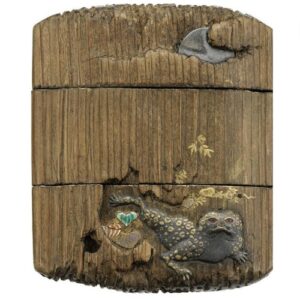
Photo Courtesy of Christie’s.
An inro is a small (10 x 5 x 2 cm approx.,) traditional Japanese, compartmentalized case used to transport necessities such as coins, tobacco, etc. They are beautifully enhanced by lacquer, inlaid metal, mother-of-pearl, intricate carvings, and other decorative techniques. Inro are composed most commonly of wood, ivory, tortoise and metal. They are suspended from a cord and hung from the obi sash on a kimono. The closure strung on the inro cords is a functional bead known as an ojime.
Sumptuary laws did not restrict the use of an inro. Eventually, they evolved to reflect the wealth and status of the wearer. Since jewelry was forbidden, design efforts in the decorative arts concentrated on these pocket substitutes. A further decorative element was the netsuke, which served as a counterweight at the end of the cords. Japanese inro, netsuke, and ojime were incredible, miniature artworks and remain highly collectible today.
As Japan was opened to trade after 1854, Western dress began to replace the kimono and its accessories. By the turn of the century, the Japanese industrial revolution was in full swing, and few netsuke, ojime, and inro were made. Today, netsuke and ojime are again being created as works of art.[note Dubin, p.62][/note]
Source
Dubin, Lois Sherr. The History of Beads: From 30,000 B.C. to the Present, Concise Edition. New York, NY: Harry N. Abrams, Inc., 1998.